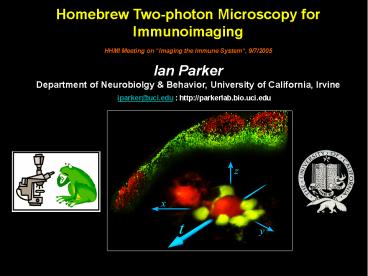Homebrew Two-photon Microscopy for Immunoimaging - PowerPoint PPT Presentation
Title:
Homebrew Two-photon Microscopy for Immunoimaging
Description:
Homebrew Twophoton Microscopy for Immunoimaging – PowerPoint PPT presentation
Number of Views:252
Avg rating:3.0/5.0
Title: Homebrew Two-photon Microscopy for Immunoimaging
1
Homebrew Two-photon Microscopy for
Immunoimaging HHMI Meeting on Imaging the
Immune System, 9/7/2005 Ian Parker Department
of Neurobiolgy Behavior, University of
California, Irvine
iparker_at_uci.edu http//parkerlab.bio.uci.edu
2
Whats missing from this picture?
1. Single-cell dynamics
2. Tissue level interactions
Despite a relatively sophisticated understanding
of molecular immunology, it is surprising that we
know so little about the cellular dynamics that
initiate and regulate the immune response in
vivo.
Gowans JL, Immunology Today, 1996
3
Dendritic cells- as studied by a neurobiologist
Dendritic cells as studied by an immunologist
4
2-photon imaging in live tissues
100 ?m
PF
AL
TZ
DC
C
M
25 ?m
EL
15 ?m
5 ?m
Miller et al., 2002. Science 296 1869 - 1873
5
Fluorescence imaging the need for optical
sectioning
Pollen grain viewed by conventional
fluorescence microscopy
Two-photon sections through pollen grain
6
2-photon excitationNear-simultaneous (ca.
10-19s) absorption of energy from two photons,
each with half the energy (twice the wavelength)
of that normally required to excite the
fluorophore
Molecular Expressions Microscopy Primer
7
Principles of multi-photon microscopy
8
Advantages of two-photon vs. confocal microscopy
1. Photobleaching minimized to the plane of focus
Molecular Expressions Microscopy Primer
and photodamage similarly restricted BUT
susceptibility to non-linear damage processes
B cells T cells Laser power increased from 30 to
75 mW
9
Advantages of two-photon microscopy
2. Greater depth penetration (gt 400 mm) into
scattering biological tissue
Two-photon Confocal
Light scattering varies inversely as the
fourth power of wavelength
(Which is why the sky is blue and sunsets are red)
Increasing depth
So, infrared light used for two-photon
imaging penetrates much deeper than blue light
10
Custom-built video-rate 2-P microscope
(The Original)
11
Advantages of the Parker homebrew 2-photon
microscope
- Price! lt 300k for a complete system
(microscope, laser, computer, software, air
table). - Video-rate or faster (30 fps, or at reduced frame
size 60 or 120 fps). Faster time-lapse imaging
of 3D volumes (but trade-off with image quality
via frame averaging).
E.g. Labeled T cell flowing in small vessel In
lymph node superposition of 9 video frames
(300 ms total)
Real-time viewing very helpful for locating
regions of interest within tissues/organs
- High sensitivity good quality images
- Readily customized -
- service engineer always available on-site!
- 5. Building your own microscope is fun and
satisfying!
12
Key design features
- Resonant x-scan mirror for high speed (64 ms /
line) imaging - 450 lines/frame at 30 fps.
CRS scanner GSI Lumonics
Custom software interlaces alternating right-left
scans, and corrects for image distortion
13
Four-channel imaging PMT detectors close to
objective for maximalcollection of scattered
fluorescence
14
Objective lens is critical. Good IR transmission
and correction high numerical aperture
water-dipping to avoid need for coverglass
long working distance
20X water NA 0.95
60x water NA 1.2
Self B cells Allo CD4 T cells Allo CD8 T cells
15
Whats involved in building a 2-P microscope?
Scanner module
1
Detector module
2
Detail of scan mirror assembly
Control electronics
3
16
Building a system is now easier
Custom circuit board (Mike Sanderson)
Custom software (Video Savant)
17
Offspring of the original video-rate homebrew
Mike Sanderson, U. Mass (x 2!)
Mark Miller, Wash. U
Grace Stutzmann, Chicago Med. School
Jerry Sedgewick, Univ. Minnesota
Max Krummel, UCSF
Dirk vanHelden, Newcastle, Australia
18
Two-Photon Imaging of Lymph Nodesexplant and
intravital preparations
DO11.10 donor
Continuously superfuse with medium 36oC, 95
O2/5CO2
Isolate antigen specific T cells
Inject CFSE-labeled T cells
BALB/c recipient
Lymph node explant or intravital prep
19
Explanted vs. in vivo lymph node preparations
explant closely replicates the in vivo
environment in many instances
B cells
T cells
Macroscopic T cell movements approximate a
random walk in both preparations, with similar
quantitative values
explant
in vivo Mean T cell velocity
10.8 10.2 - 11.5 mm min-1 Motility
coefficient 67 72
mm2 min -1
20
Some advantages of the explanted lymph node
preparation
Explant provides better image quality no
movement artifacts, no overlying fat
cells Can look at hard-to-get-to regions of
the lymph node e.g. imaging
transendothelial T cell migration into
medullary sinuses
Facilitates pharmacological studies Rapid and
reversible application of drugs via superfusate
21
But the in vivo preparation is the most
physiological, and some processes can only be
studied in vivo
e.g. homing of T cells into the lymph node
raw volume rendition
Color depth-encoded
Circles mark homing events
22
Ongoing and Future Directions
Endoscopic probes for imaging deep within
living animals (Levene et al., J. Neurophysiol.
911908, 2004)
- Fluorescent Probes
- Ca2
- Q-dots
- Genetically-engineered probes
- (GFP-tagged proteins functional
- reporters)
Biophysical analysis and modeling of cell
trafficking
23
Acknowledgements
Michael D. Cahalan Mark J. Miller Sindy H.
Wei Melanie Matheu Debasish Sen The NIH for
support































